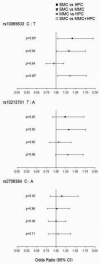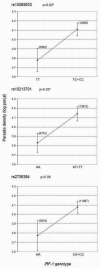Interferon regulatory factor-1 polymorphisms are associated with the control of Plasmodium falciparum infection
- PMID: 18200030
- PMCID: PMC2963926
- DOI: 10.1038/sj.gene.6364456
Interferon regulatory factor-1 polymorphisms are associated with the control of Plasmodium falciparum infection
Erratum in
- Genes Immun. 2008 Jul;9(5):482. Akha, E S [corrected to Sadighi Akha, E]
Abstract
We describe the haplotypic structure of the interferon regulatory factor-1 (IRF-1) locus in two West African ethnic groups, Fulani and Mossi, that differ in their susceptibility and immune response to Plasmodium falciparum malaria. Both populations showed significant associations between IRF-1 polymorphisms and carriage of P. falciparum infection, with different patterns of association that may reflect their different haplotypic architecture. Genetic variation at this locus does not therefore account for the Fulani-specific resistance to malaria while it could contribute to parasite clearance's ability in populations living in endemic areas. We then conducted a case-control study of three haplotype-tagging single nucleotide polymorphisms (htSNPs) in 370 hospitalised malaria patients (160 severe and 210 uncomplicated) and 410 healthy population controls, all from the Mossi ethnic group. All three htSNPs showed correlation with blood infection levels in malaria patients, and the rs10065633 polymorphism was associated with severe disease (P=0.02). These findings provide the first evidence of the involvement in malaria susceptibility of a specific locus within the 5q31 region, previously shown to be linked with P. falciparum infection levels.
Figures



Similar articles
-
Genetic complexity of Plasmodium falciparum in two ethnic groups of Burkina Faso with marked differences in susceptibility to malaria.Am J Trop Med Hyg. 2004 Aug;71(2):173-8. Am J Trop Med Hyg. 2004. PMID: 15306706
-
The lower susceptibility to Plasmodium falciparum malaria of Fulani of Burkina Faso (west Africa) is associated with low frequencies of classic malaria-resistance genes.Trans R Soc Trop Med Hyg. 2001 Mar-Apr;95(2):149-52. doi: 10.1016/s0035-9203(01)90141-5. Trans R Soc Trop Med Hyg. 2001. PMID: 11355545
-
Functional deficit of T regulatory cells in Fulani, an ethnic group with low susceptibility to Plasmodium falciparum malaria.Proc Natl Acad Sci U S A. 2008 Jan 15;105(2):646-51. doi: 10.1073/pnas.0709969105. Epub 2008 Jan 3. Proc Natl Acad Sci U S A. 2008. PMID: 18174328 Free PMC article.
-
Genetic epidemiology of susceptibility to malaria: not only academic exercises.Parassitologia. 2008 Jun;50(1-2):147-50. Parassitologia. 2008. PMID: 18693583 Review.
-
Folic acid supplementation and malaria susceptibility and severity among people taking antifolate antimalarial drugs in endemic areas.Cochrane Database Syst Rev. 2022 Feb 1;2(2022):CD014217. doi: 10.1002/14651858.CD014217. Cochrane Database Syst Rev. 2022. PMID: 36321557 Free PMC article.
Cited by
-
Tagging single nucleotide polymorphisms in the IRF1 and IRF8 genes and tuberculosis susceptibility.PLoS One. 2012;7(8):e42104. doi: 10.1371/journal.pone.0042104. Epub 2012 Aug 6. PLoS One. 2012. PMID: 22879909 Free PMC article.
-
A genome scan for Plasmodium falciparum malaria identifies quantitative trait loci on chromosomes 5q31, 6p21.3, 17p12, and 19p13.Malar J. 2014 May 28;13:198. doi: 10.1186/1475-2875-13-198. Malar J. 2014. PMID: 24884991 Free PMC article.
-
Host candidate gene polymorphisms and clearance of drug-resistant Plasmodium falciparum parasites.Malar J. 2011 Aug 25;10:250. doi: 10.1186/1475-2875-10-250. Malar J. 2011. PMID: 21867552 Free PMC article.
-
Investigation of host candidate malaria-associated risk/protective SNPs in a Brazilian Amazonian population.PLoS One. 2012;7(5):e36692. doi: 10.1371/journal.pone.0036692. Epub 2012 May 16. PLoS One. 2012. PMID: 22615793 Free PMC article.
-
Genetic polymorphisms linked to susceptibility to malaria.Malar J. 2011 Sep 19;10:271. doi: 10.1186/1475-2875-10-271. Malar J. 2011. PMID: 21929748 Free PMC article. Review.
References
-
- Kroger A, Koster M, Schroeder K, Hauser H, Mueller PP. Activities of IRF-1. J Interferon Cytokine Res. 2002;22:5–14. - PubMed
-
- Imanishi D, Yamamoto K, Tsushima H, Miyazaki Y, Kuriyama K, Tomonaga M, et al. Identification of a novel cytokine response element in the human IFN regulatory factor-1 gene promoter. J Immunol. 2000;165:3907–3916. - PubMed
-
- Guo Z, Garg S, Hill KM, Jayashankar L, Mooney MR, Hoelscher M, et al. A distal regulatory region is required for constitutive and IFN-beta-induced expression of murine TLR9 gene. J Immunol. 2005;175:7407–18. - PubMed
-
- Foss GS, Prydz H. Interferon regulatory factor 1 mediates the interferon-gamma induction of the human immunoproteasome subunit multicatalytic endopeptidase complex-like 1. J Biol Chem. 1999;274:35196–35202. - PubMed
-
- Manzella L, Conte E, Cocchiaro G, Guarniera E, Sciacca B, Bonaiuto C, et al. Role of interferon regulatory factor 1 in monocyte/macrophage differentiation. Eur J Immunol. 1999;29:3009–3016. - PubMed
Publication types
MeSH terms
Substances
Grants and funding
LinkOut - more resources
Full Text Sources

